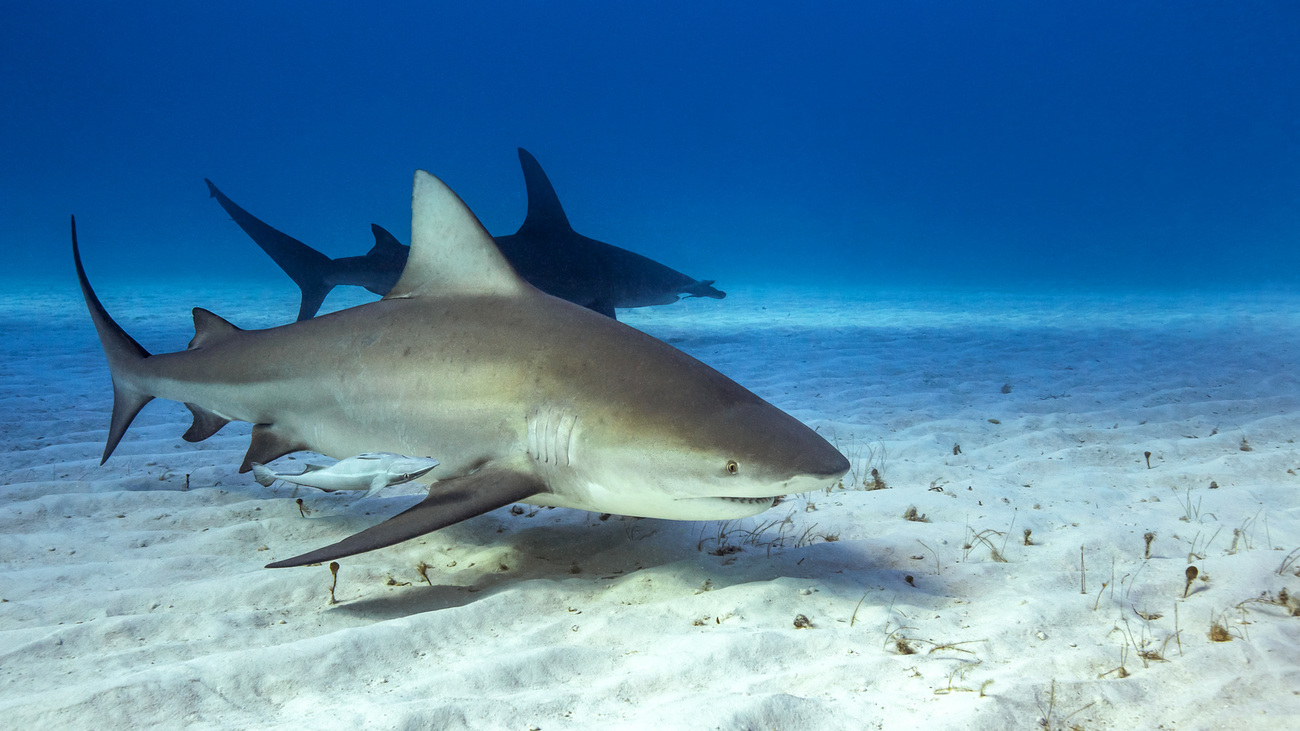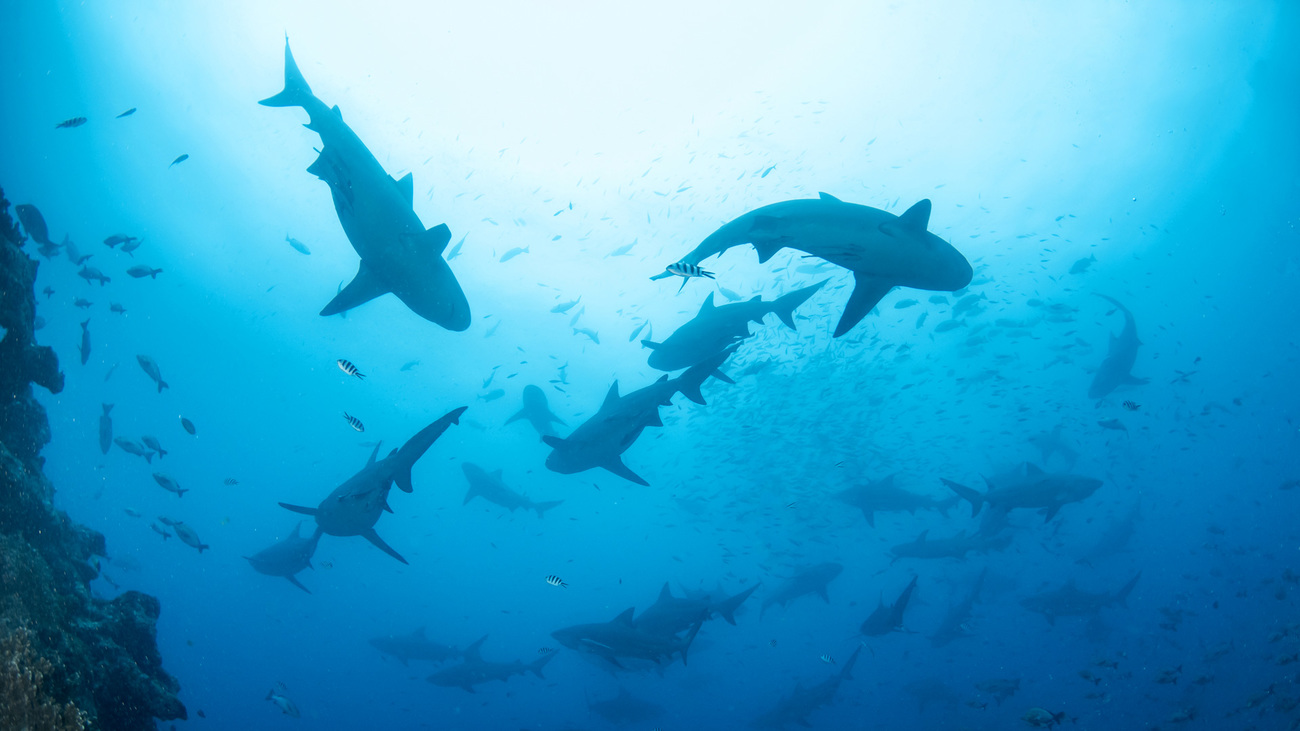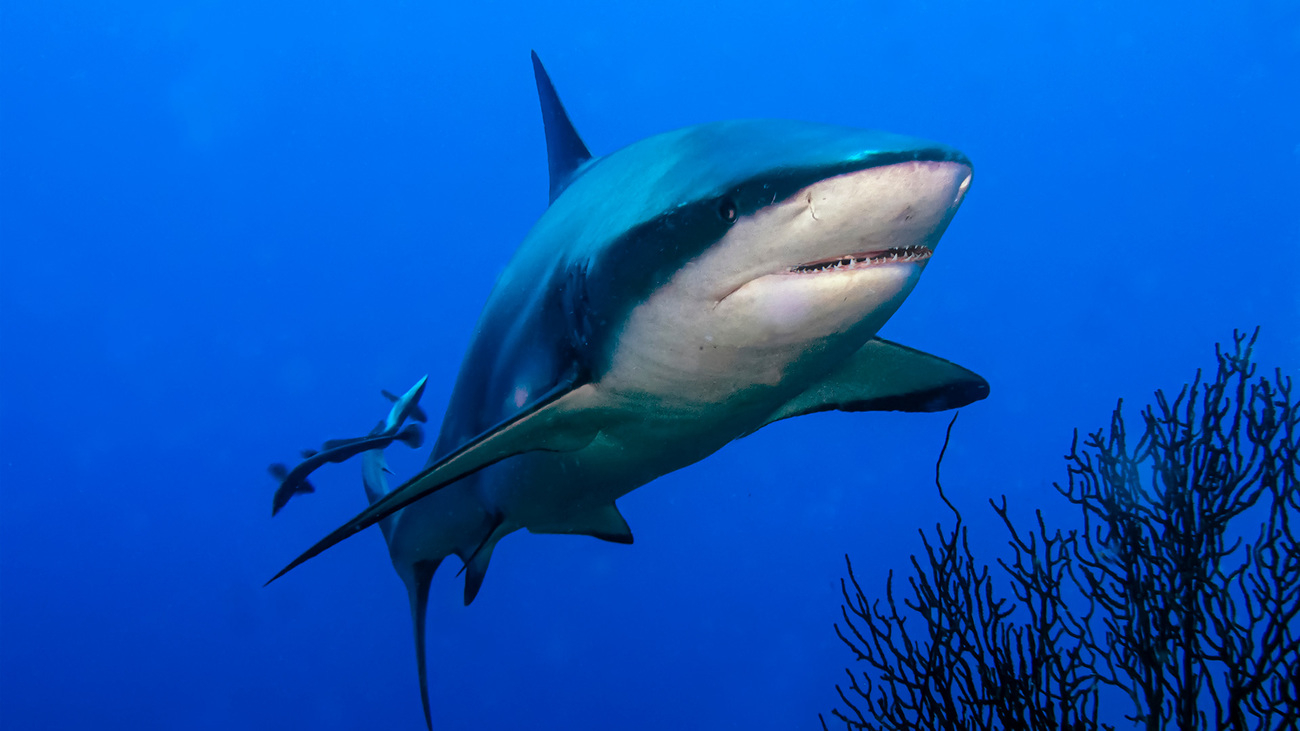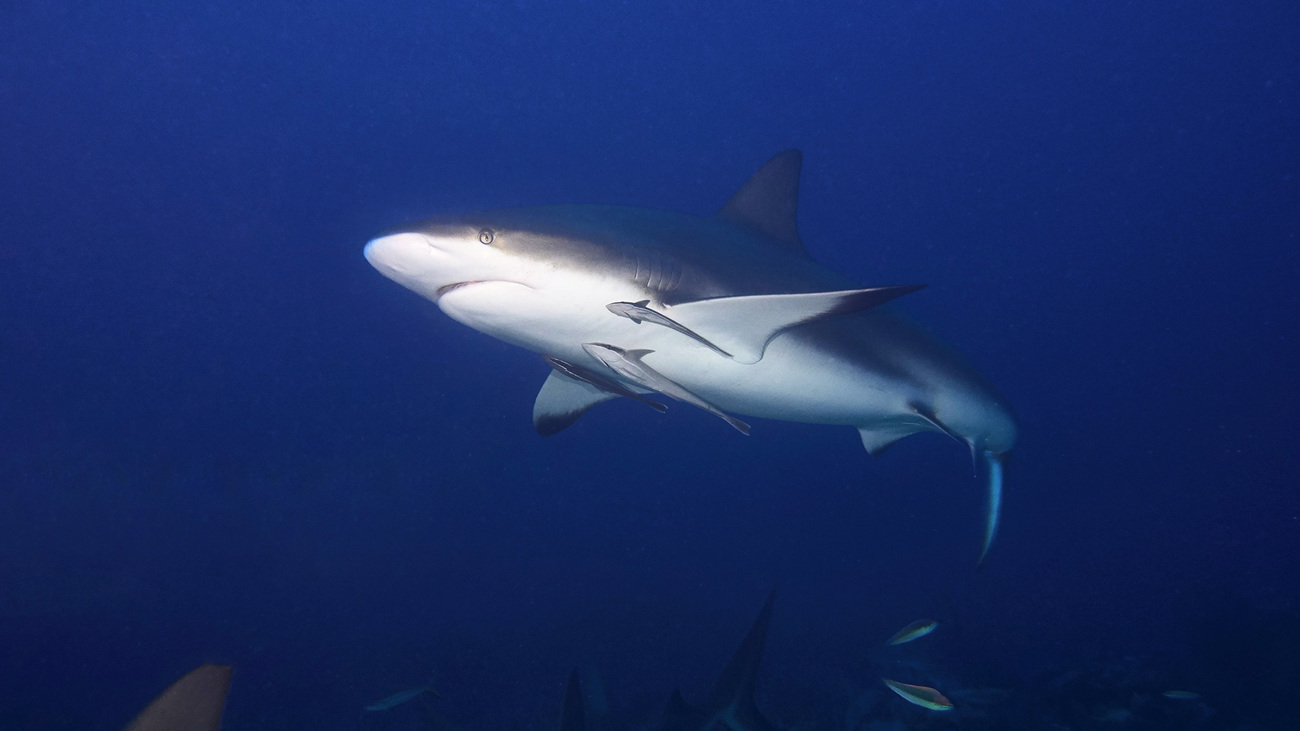Bull sharks
Bull sharks are found in shallow, warmer coastal waters worldwide, often near where humans prefer to swim. They’re highly territorial creatures, especially during breeding season. While humans are not part of a bull shark’s usual diet, they’re known to be aggressive towards humans and are thought to be one of the most dangerous shark species in the world. However, shark attacks are extremely rare, with fewer than 20 fatalities caused by sharks each year.
Bull sharks have a unique ability to tolerate freshwater and saltwater habitats, meaning they can sometimes be found venturing into rivers and travelling great distances upstream. As one of few shark species that inhabit freshwater environments, they’ve earned the nickname ‘river sharks’.
Sitting at the top of the food chain, bull sharks are opportunistic feeders, meaning they consume a variety of prey. Their diet typically consists of fish, rays, sea turtles, birds, dolphins, and even other sharks. Usually, they’ll head-butt their prey before going in for the kill. Bull sharks have powerful jaws, giving them a tremendous bite force useful for capturing challenging prey. Their muscular and robust bodies also give bull sharks a predatory advantage in speed and power.
Female bull sharks tend to be bigger than males, reaching lengths of 4 metres and weighing around 315 kilograms, while males usually grow to around 3.6 metres long. Bull sharks are characterised by their short, flat snouts, broad heads, and pointed noses. They are well-camouflaged, with their grey to light brown upper bodies and white undersides allowing them to effectively blend into their marine environment.
Like humans, bull sharks reproduce through viviparity, the process in which the embryo develops within the mother’s body, leading to live birth. Male bull sharks reach sexual maturity at 9 to 10 years old, and female bull sharks are sexually mature at around age 10. The bull shark’s gestation period lasts around 10 to 11 months, after which 1 to 13 pups are born, emerging from the mother tail first. They are usually born in the spring or summer. The average size of a pup is just under one metre long. The typical lifespan of a bull shark is about 12 to 16 years, though they have been known to live as long as 30 years in captivity.
As apex predators, bull sharks play an essential role in maintaining the crucial balance of the marine food web. They help control the populations of their prey, which is key to preventing the overgrazing of seagrass beds and coral reefs and maintaining the health and stability of these sensitive habitats. This applies to their usual ocean environments and the rivers and estuaries where they can sometimes be found. In maintaining a healthy marine ecosystem, bull sharks contribute to climate change mitigation. These ecosystems are vital to the global sequestration of carbon dioxide—a greenhouse gas contributing to the quickening pace of global warming.
Despite their importance to the health and balance of our planet, bull sharks unfortunately face threats to their survival, including fishing, habitat loss, and climate change. Conservation efforts are essential to safeguard these apex predators and the ecosystems they inhabit.
It’s important to recognise the vital role of bull sharks in our world. Let’s get to know them a little better with some facts about this fascinating species.
What is a bull shark’s scientific name?
A bull shark’s scientific name is Carcharhinus leucas. Carcharhinus translates to ‘sharp-nosed’. Although this description applies to the majority of sharks in this genus, bull sharks have rounder, more stout noses. Leucos translates to ‘white’ and refers to the bull shark’s white underside.
Bull sharks are sometimes called ‘river sharks’ because they can live and breed in freshwater habitats.
Are bull sharks endangered?
According to the IUCN Red List, bull sharks have been classed as vulnerable since 2020, and their population is decreasing. Prior to 2020, bull sharks were considered near threatened.
Where do bull sharks live?
Bull sharks are frequently spotted in tropical coastal areas worldwide, including shallower waters along coastlines. In the US, they’re known to occupy the shores of the East Coast and the Gulf of Mexico. They tend to inhabit bays, estuaries, and coastal lagoons. The bull shark’s unique ability to tolerate both saltwater and freshwater makes them well-suited to these environments, where the salinity of the water can sometimes vary. Although their usual habitat is in the ocean, they are known to swim long distances into rivers. They have been found 2,400 miles up the Amazon River and even have a semi-permanent population in Lake Nicaragua.
Threats
Bull sharks are facing a range of threats that endanger their populations. As a result, the health of the ecosystems they inhabit is also threatened. Their primary threats include fishing, habitat degradation, climate change, and beach protection programmes.

Fishing
Unfortunately, bull sharks are often unintentionally caught as bycatch in various fishing operations, including gillnets, longlines, and trawl fishing.
They are also targeted for their meats, oils, hides, and fins, which are particularly valuable in some markets. Overfishing can accelerate the decline of the bull shark population, disrupting the balance of their marine and freshwater habitats.
Habitat degradation
Habitat degradation poses a significant threat to the survival of the bull shark species, especially in coastal waters. Due to their close proximity to human life, they often face the consequences of human activities like urban development, deforestation, and agriculture. Water pollution and the destruction of their habitat can reduce the availability of food and shrink the areas where they can breed and nurse their young.
Climate change
Climate change is also threatening the survival of bull sharks. Rising sea temperatures, ocean acidification, and altered ocean currents disrupt the distribution and availability of prey species, making it more challenging to find food sources.
Beach protection programmes
Beach protection programmes are often put in place to reduce the likelihood of shark attacks. However, the methods they use, including shark nets and culling initiatives, can inadvertently harm bull shark populations in their own native habitats. Shark nets, for example, can trap and kill this ecologically important species. This is a particular issue in South Africa, Réunion, and Australia.
Replacing nets with alternative migration strategies in places where the catch rate of bull sharks is particularly high could prevent unnecessary deaths.
FAQs
Do bull sharks attack humans?
Yes, bull sharks have been known to attack humans and are considered one of the most dangerous shark species. The habitat of the bull shark tends to be around coastal waters and rivers where the chances of human-shark interaction are higher. They are an aggressive and territorial species, so it’s best to avoid bull sharks.
However, since 2000, there have been only 27 unprovoked bull shark attacks on humans in the United States, with only one fatality. The majority of human encounters with bull sharks do not result in attacks.
Are bull sharks bigger than great white sharks?
No, great white sharks tend to be larger than bull sharks. Great white sharks can reach lengths of up to 6 metres, while bull sharks generally grow to around 4 metres long. However, as bull sharks are more muscular than great whites, they can sometimes look a lot bigger.

How long do bull sharks live?
Bull sharks have been observed to live up to 16 years in the wild. However, in captivity, they have been known to live almost twice as long, up to 30 years.
Are there bull sharks in the Great Lakes?
Although bull sharks can live in freshwater habitats, bull sharks are not native to the Great Lakes in North America. While they have been spotted in various estuaries and rivers, they aren’t generally found in the Great Lakes themselves. Though there have been occasional rumours and reports of bull sharks in the Great Lakes, these claims are often unverified or based on isolated incidents.
What animal hunts bull sharks?
Unfortunately, humans are the main predators of bull sharks through fishing and hunting activities, as well as habitat degradation that results from various human activities. Other than humans, bull sharks sit at the top of the food chain as apex predators, meaning they have no natural predators.
However, they can still be hunted or preyed upon by other animals in specific circumstances. For instance, although it is rare, larger sharks like great white and tiger sharks can sometimes prey on bull sharks.
When in freshwater areas, younger bull sharks may also be preyed upon by crocodiles.
Are bull sharks endangered?
While bull sharks are not currently an endangered species, they are listed as vulnerable on the IUCN Red List. They have a declining population, which means they may become endangered in the future.
What does a bull shark eat?
Bull sharks are opportunistic predators at the top of the food web. They have a diverse diet, consuming a wide variety of prey depending on the availability of food in their habitat. Some of the more common prey in their diet include fish, rays, smaller sharks, sea turtles, and birds. Though it’s rare, bull sharks have also been observed to feed on dolphins and crustaceans.
How do bull sharks reproduce?
Bull sharks are viviparous, meaning their embryos develop inside the mother’s body, rather than in eggs. Fertilisation takes place inside the mother, and they have a gestation period of 10 to 11 months. Newborn bull sharks are called pups, and they are born tail-first in litters of up to 13. Bull shark pups are well-developed and are able to swim and even hunt shortly after birth.
How many rows of teeth do bull sharks have?
Like many other sharks, bull sharks have multiple rows of teeth. Typically, there are 12 to 13 rows of anteroposterior teeth in each half of the jaw, although some have 14.
Our work
IFAW is committed to ensuring the survival of shark species found in international trade, such as requiem sharks (including bull sharks). We have collaborated closely with member nations of the Convention on International Trade in Endangered Species of Wild Fauna and Flora (CITES), working to establish restrictions on the international trade of endangered shark species. At the request of governments, we provide support to ensure that any ongoing trade adheres to legal and sustainable sourcing practices, as specified under Appendix II of the Convention.
Species listed under CITES benefit from vigilant monitoring, regulation, and the enforcement of sustainable catch and trade limits by governments worldwide. This includes the detection and confiscation of illegal shipments of shark products.
In support of these shark safeguarding initiatives, IFAW provides training in identification and enforcement, along with the development of technical tools. These resources assist governments in their endeavours to enact CITES listings for sharks and rays within their own jurisdictions.
We believe that these listings can act as a global framework for establishing sustainable trade limits for shark species, resulting in significant reductions in shark mortalities to prevent their extinction.

How can you help?
Bull sharks face threats of fishing, habitat degradation, climate change, and beach protection programmes. IFAW is working to protect them and mitigate these issues.
